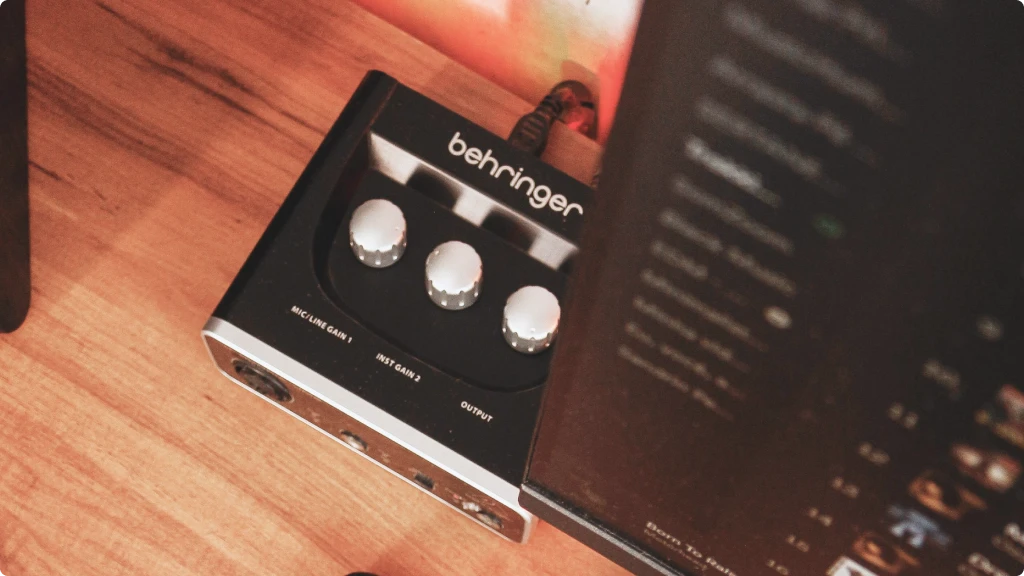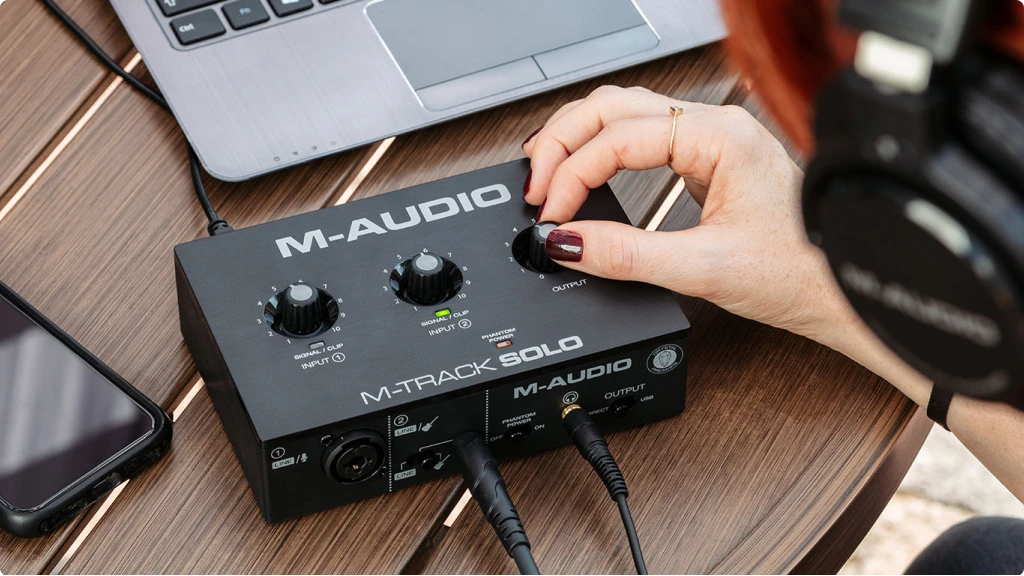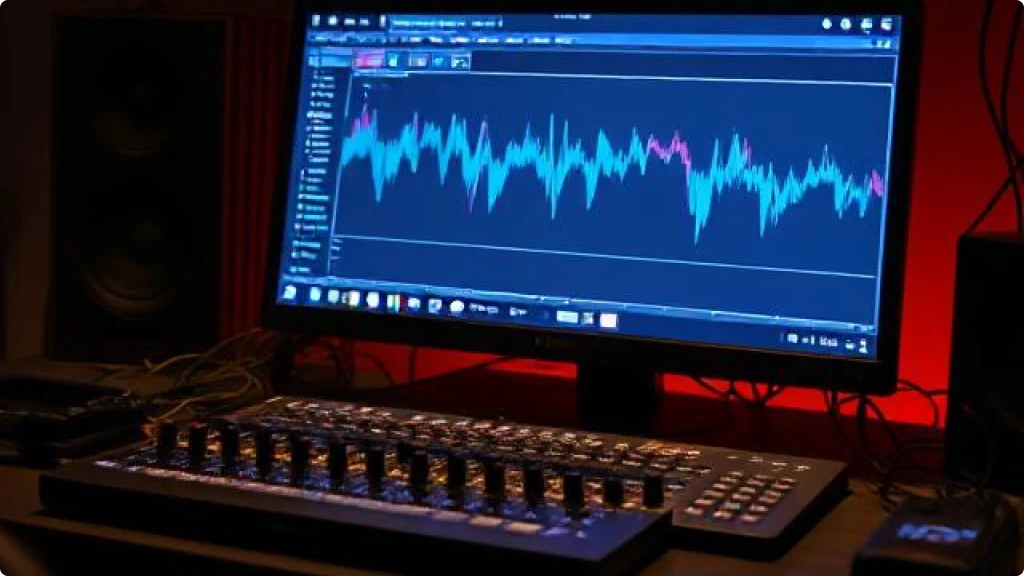
Best Audio Hub tests and reviews audio interfaces. Our articles may include affiliate links and we may earn a commission. Read more about how we evaluate products.
1. Introduction
If you’re struggling to achieve professional-quality sound from your recordings, you’re not alone. Many creators, whether podcasters, streamers, musicians, or producers, face challenges with noise, latency, and clarity.
However, the right tools and techniques can make all the difference.
Audio interfaces improve sound quality and are the cornerstone of a great recording setup. It improves sound quality by converting analog signals into digital audio, minimizing noise, and providing essential controls like preamps and gain settings.
In this guide, we’ll dive deep into the ways an audio interface can enhance your sound quality and share actionable tips to maximize its potential.
2. Choose the Right Interface for Your Needs

Selecting an audio interface that meets your specific needs is crucial. Interfaces come in a range of styles, from beginner models to high-end options.
For instance, if you’re a beginner, you might consider the Focusrite Scarlett 2i2 3rd Gen, known for its simplicity and quality or the Vocaster One, featuring Camera Output, Auto Gain and Enhance, ideal for podcasters and streamers.
However, a more advanced users or streamers may benefit more from the Apollo Solo, which includes built-in DSP processing or the Focusrite Clarett+ 4Pre with its top-tier preamps.
Consider These Features when choosing an audio interface:
- Number of Inputs and Outputs: Choose an interface that accommodates your instruments and mics.
- Connectivity: USB and Thunderbolt are common. Thunderbolt offers lower latency but comes at a higher price.
- Built-In Features: Look for preamps, gain control, and monitoring options.
3. Set Up in a Quiet Space
Sound reflects and bounces in closed spaces, creating unwanted noise or distortion. Acoustic treatment minimizes these effects.
Acoustic Tips:
- Foam Panels: Absorb mid-to-high frequencies to reduce echo.
- Bass Traps: Manage low-end frequencies in corners.
- DIY Options: Blankets or thick curtains can work as temporary solutions.
A quiet, well-treated room ensures your audio interface captures clean sound without interference.
4. Use High-Quality Cables
Cables play a pivotal role in maintaining audio clarity. TRS (Tip-Ring-Sleeve) and XLR cables are the most reliable for balanced connections, reducing noise and hum.
- TRS Cables: Commonly used for line-level signals and short distances.
- XLR Cables: Ideal for microphones and long-distance connections due to their durability and balanced signal transmission.
Investing in durable, well-shielded cables helps ensure that your setup isn’t compromised by electrical interference, which can come from nearby devices or power cables.
5. Adjust Your Gain Levels Properly

Clipping occurs when the input signal exceeds the maximum limit your interface can handle, causing distortion. This is often visible as red peaks on your interface’s meters.
How to Avoid Clipping:
- Keep gain levels in the green or yellow range.
- Use your DAW’s monitoring tools for precision.
Overloading the gain can cause unwanted distortion, while setting it too low may make your recordings sound thin or weak.
6. Enable Direct Monitoring

Direct monitoring reduces latency, which is the delay between playing sound and hearing it through your headphones. With direct monitoring enabled, you’ll hear the sound as it’s being recorded, with virtually no delay.
This feature is essential for musicians and streamers who need real-time audio feedback. Many popular interfaces, like the Focusrite Scarlett 2i2 3rd Gen and M-Audio AIR 192|6, come with a direct monitoring button for easy access.
7. Select the Right Sample Rate and Bit Depth

Higher sample rates and bit depths improve sound quality, but they also increase file size and CPU load. For most home studios, a 24-bit depth and 48kHz sample rate offer a good balance of quality and performance.
However, if you’re recording high-fidelity music or need more headroom, 96kHz can be beneficial. Most importantly, choose settings that your computer and DAW can handle without slowing down.
- Sample Rate: 44.1kHz is standard, but 48kHz or 96kHz offers better fidelity.
- Bit Depth: Use 24-bit for more headroom and dynamic range.
Most DAWs, like Ableton Live and Reaper, let you configure these settings easily.
8. Position Your Microphone Correctly
For vocal recordings and streaming, cardioid condenser microphones are often preferred due to their sensitivity and ability to focus on the sound source while minimizing background noise.
The microphone should be slightly below or level with the vocalist’s mouth. Slightly angle the microphone off-axis to reduce sibilance and harshness.
Use a pop filter, positioned about 2–4 inches (5-10 cm) from the mic, effectively diffuses these bursts, resulting in smoother recordings.
For musicians, dynamic microphones, are ideal for guitar and bass amps due to their ability to handle high sound pressure levels (SPL). For acoustic instruments, condenser microphones provide a richer, more detailed sound.
Position the mic 1–3 inches (2,5 – 8 cm) from the amp’s speaker cone for a direct, focused sound. Adjust between the center (bright tones) and edge (warm tones) of the cone.
9. Use High-Quality Preamp Settings
Good preamps are essential for clear, natural sound. Some audio interfaces, like the Focusrite Clarett+ 4Pre series, include premium preamps with options like Air Mode, which adds brightness.
Adjust preamp settings carefully to avoid unnecessary noise. Remember that different preamp levels suit different instruments. Experiment with settings to see which configurations work best for your setup.
10. Control Background Noise and Hum

Electrical hum and environmental noise can degrade recordings. Balanced cables and noise gates plugins help reduce these issues. There are many noise gate plugins available, both free like ReaGate and paid like iZotope RX Voice De-Noise and FabFilter Pro-G.
Keep power cables separate from audio cables. Grounding your equipment properly can also minimize hum, while noise gates help cut out low-level noises during silent parts.
11. Use Monitoring Headphones or Studio Monitors
While regular headphones and speakers are designed for casual listening, studio monitors and headphones are tailored for critical audio work, ensuring precise, uncolored sound.
Regular headphones and speakers are optimized for enjoyment. They often feature enhanced bass and treble to make music sound more dynamic and engaging. This “colored” sound boosts certain frequencies, which can make music more exciting for casual listeners but distorts the original balance intended by the producer.
Studio monitors and headphones are designed to provide a flat frequency response, meaning they reproduce audio as accurately as possible without artificial enhancements. This allows producers, musicians, and engineers to hear the true sound of their recordings, identifying flaws and balancing elements effectively.
12. Conclusion: How Audio Interfaces Improve Sound Quality
Audio interfaces improve sound quality and are indispensable for achieving good results. They reduce noise, handle gain effectively, and provide essential monitoring tools. With the right setup, you’ll elevate your recordings and create consistent, high-quality audio for any purpose.
Don’t forget to explore our guides on the Best Audio Interface for additional recommendations tailored to specific needs, like streaming or recording on a Mac. With these tips, you’ll be ready to create professional-quality recordings from the comfort of your home studio.
13. FAQ
Do budget friendly audio interfaces improve sound quality?
Yes, even budget-friendly audio interfaces improve sound quality significantly compared to built-in sound cards in computers.
They offer features like higher-quality preamps, better analog-to-digital converters, and balanced inputs that reduce noise and distortion. While premium interfaces might provide additional features like DSP processing or higher sampling rates, budget options still enhance clarity and reduce latency, making them ideal for beginner musicians, podcasters, and streamers.
Do audio interfaces improve sound quality for streaming?
Absolutely! Audio interfaces improve sound quality for streaming by reducing noise and ensuring a cleaner, more professional signal. Features like direct monitoring eliminate latency, allowing streamers to hear themselves in real time without delays. Additionally, many interfaces include preamps and phantom power for connecting high-quality microphones, which are crucial for clear and consistent voice recordings.
For streamers seeking the best setups, check out our guide How to Use an Audio Interface for Streaming: Best Tips
How to Chose an Audio Interface

The first thing you should do when choosing an audio interface is to assess your needs.
I’ve had the chance to use dozens of audio interfaces over the years, in different contexts as a musician and producer, and I can tell you that there is no one-size-fits-all solution.
Ask yourself what you want to achieve. Are you just practicing your instrument? Recording an album? Streaming online or starting a podcast? There are many use cases for audio interfaces, so read our reviews, compare brands, models and features.
Here we try to make your decision easier by providing unbiased reviews and buying options of tested audio interfaces, so, get deep into research and compare prices.
Inputs and Outputs
There are basically 4 main inputs available on audio interfaces, XLR inputs designed for microphones, TRS inputs for instruments like keyboards, Hi-Z instrument inputs for guitars and bass, and MIDI inputs for drum machines and synths.
Now, assess your needs. A solo musician may only need two inputs for vocals and guitar, but a producer working with multiple instruments may need four or more, and a podcaster hosting a dozen guests at once would need many more inputs.
Of course, the number of outputs also matters, especially if you are connecting studio monitors or multiple headphone outputs, determine where you want to send the signal and choose the right number of outputs you need.
Assess your needs, check the connectivity of your equipment, and find the best audio interface for your use case.
Compatibility and Connectivity
Connectivity is vital for seamless integration. USB interfaces are common and compatible with most computers, while Thunderbolt models offer faster speeds and lower latency (delay).
So make sure your interface is compatible with your preferred DAW and operating system, especially if you’re a Mac user. Most interfaces are compatible with both Mac and Windows, but some are also compatible with iOS and Android.
Features
Important features to look for include the quality of preamps, resolution, direct monitoring and DSP cores.
Consequently, high-quality preamps give cleaner sound, and a resolution ensures clarity and quality recordings at both low and high levels. Direct monitoring will allow you to hear yourself in real time, no delay, and DSP processing is helpful for real-time effects, especially in live streaming.
If you want to use condenser mics, you will need a phantom power feature to power your mic. It won’t work without it.
Budget and Price Range
When choosing an audio interface, consider your budget. Entry-level models are available for under $200 and offer solid quality but fewer inputs and special features.
Mid-range models go somewhere between $200 and $500. Mid-range audio interfaces generally have better sound capabilities, more inputs, and extra features.
In the same way, premium models can cost over $500 and are ideal for those who need superior sound and multiple inputs; a 16-input model would be ideal for recording drums, for example.

Bassist, guitarist and producer with a long history in bands, I’ve spent more than 20 years immersed in music and gear. When I’m not playing, I’m writing about audio music, studio setups, recording and everything that helps musicians sound their best.



